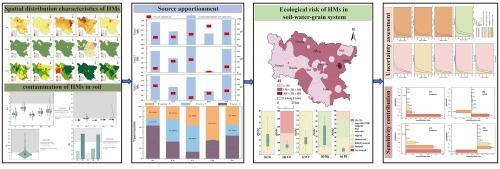Risk assessment and source apportionment of heavy metals in the soil–water-grain system in a typical area of the central Qinghai–Tibet Plateau
IF 7
2区 环境科学与生态学
Q1 ENVIRONMENTAL SCIENCES
引用次数: 0
Abstract
Heavy metals (HMs) within the soil–water-grain system have substantial effects on both eco-environmental and human health. This study collected 232 samples (58 surface soil, 89 drinking water, and 85 highland barley) from the central Qinghai–Tibet Plateau (QTP) and analyzed the contamination characteristics, source apportionments, and associated risks of arsenic (As), cadmium (Cd), chromium (Cr), mercury (Hg), and lead (Pb). The study employed geochemical normalization factors, biotoxicity assessment methods, ecological risk and health risk assessment models, and the Positive matrix factorization (PMF) model to assess the soil–water-grain system. The results showed no accumulation of HMs in highland barley, and no biotoxicity was observed. Soil was identified as the primary medium contributing to ecological and health risks, with overall risk levels ranging from slight to moderate, particularly higher in the northern and eastern regions of the study area. Cr posed non-carcinogenic risks to local children in 100% of cases and to adults in 27.27% of cases. Pb presented non-carcinogenic risks in 81.82% of cases for children and 36.36% for adults. Furthermore, As, Cd, and Cr were found to pose carcinogenic risks to both children and adults. Non-carcinogenic and carcinogenic risks were more pronounced in children than in adults. Children’s health risks were primarily driven by As concentrations in grains, with a sensitivity contribution exceeding 90%. The Monte Carlo simulation (MCS) indicated that ingestion rates were more sensitive for children, while body weight showed an inverse relationship. The PMF model identified three potential sources of HMs: anthropogenic, geogenic, and environmental. Therefore, to ensure the sustainable development of ecology and the health of residents, it is urgent to conduct routine soil remediation and maintain a balanced diet to mitigate the migration and transformation of HMs in the study area and improve the health level of residents.

青藏高原中部典型地区土壤-水-粮食系统中重金属的风险评估和来源分配
土壤-水-粮食系统中的重金属(HMs)对生态环境和人类健康都有重大影响。本研究从青藏高原中部采集了 232 个样品(58 个表层土壤样品、89 个饮用水样品和 85 个高原青稞样品),分析了砷(As)、镉(Cd)、铬(Cr)、汞(Hg)和铅(Pb)的污染特征、来源分布和相关风险。研究采用了地球化学归一化因子、生物毒性评估方法、生态风险和健康风险评估模型,以及正矩阵因式分解(PMF)模型来评估土壤-水-谷物系统。结果表明,HMs 在高原大麦中没有积累,也没有观察到生物毒性。土壤被确定为造成生态和健康风险的主要介质,总体风险水平从轻微到中度不等,尤其是在研究区域的北部和东部地区。铬对当地儿童构成非致癌风险的比例为 100%,对成年人构成非致癌风险的比例为 27.27%。铅对 81.82% 的儿童和 36.36% 的成人有非致癌风险。此外,砷、镉和铬对儿童和成人都有致癌风险。与成人相比,儿童的非致癌和致癌风险更为明显。儿童的健康风险主要受谷物中砷浓度的影响,其敏感性超过 90%。蒙特卡罗模拟(MCS)表明,摄入率对儿童更为敏感,而体重则显示出反向关系。PMF 模型确定了 HMs 的三个潜在来源:人为来源、地质来源和环境来源。因此,为确保生态环境的可持续发展和居民的健康,当务之急是进行日常土壤修复和保持均衡膳食,以缓解研究区内 HMs 的迁移和转化,提高居民的健康水平。
本文章由计算机程序翻译,如有差异,请以英文原文为准。
求助全文
约1分钟内获得全文
求助全文
来源期刊

Ecological Indicators
环境科学-环境科学
CiteScore
11.80
自引率
8.70%
发文量
1163
审稿时长
78 days
期刊介绍:
The ultimate aim of Ecological Indicators is to integrate the monitoring and assessment of ecological and environmental indicators with management practices. The journal provides a forum for the discussion of the applied scientific development and review of traditional indicator approaches as well as for theoretical, modelling and quantitative applications such as index development. Research into the following areas will be published.
• All aspects of ecological and environmental indicators and indices.
• New indicators, and new approaches and methods for indicator development, testing and use.
• Development and modelling of indices, e.g. application of indicator suites across multiple scales and resources.
• Analysis and research of resource, system- and scale-specific indicators.
• Methods for integration of social and other valuation metrics for the production of scientifically rigorous and politically-relevant assessments using indicator-based monitoring and assessment programs.
• How research indicators can be transformed into direct application for management purposes.
• Broader assessment objectives and methods, e.g. biodiversity, biological integrity, and sustainability, through the use of indicators.
• Resource-specific indicators such as landscape, agroecosystems, forests, wetlands, etc.
 求助内容:
求助内容: 应助结果提醒方式:
应助结果提醒方式:


